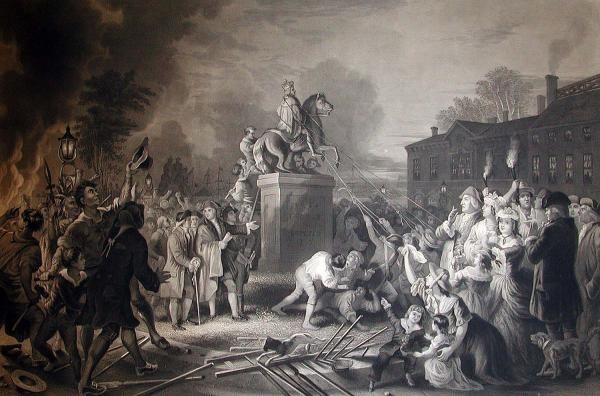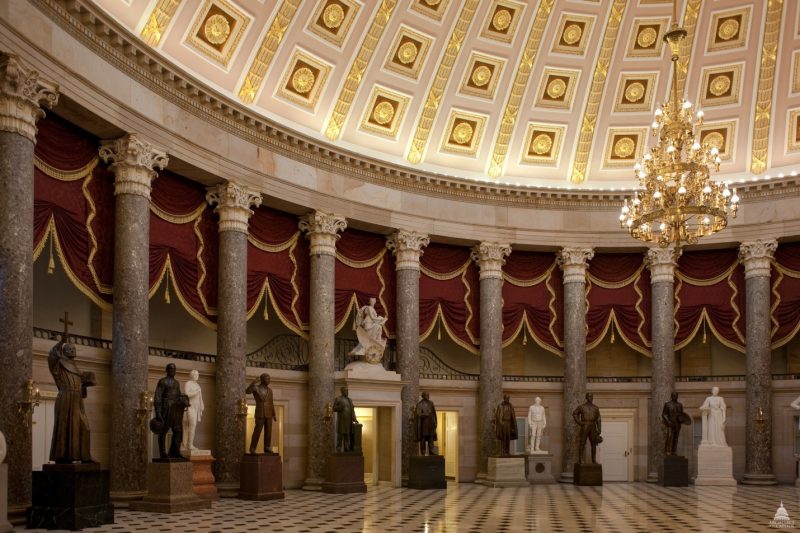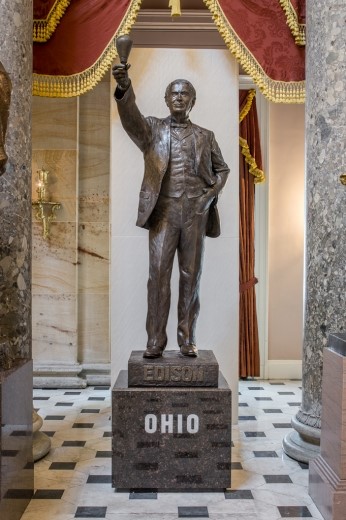America’s ever-changing commemorative landscape: a case study at National Statuary Hall
20 June 2017 – Nick Sacco

“Pulling Down Statue of King George III,” painted by Johannes A. Oertel; engraved by John C. McRae, ca. 1875. Image Credit: Library of Congress
On July 9, 1776, General George Washington, his troops, and citizens in New York City heard the Declaration of Independence for the first time. Inspired by the words of this revolutionary document, opponents of King George III ran towards a statue of his likeness in Manhattan and proceeded to tear it down, later melting it to make bullets for use in their fight for independence. As far as the historical record is concerned, no one present at the event was heard yelling “wait, you’re erasing history!” as the monument came down.
The people at King George’s monument that day understood the complex purposes of public icons in ways we often forget in our contemporary debate about the role of Confederate icons in America’s commemorative landscape. The King George monument was not a neutral commemoration of historical fact but a political statement of values. British leaders erected the statue because they believed their King deserved a public place of honor among the loyal subjects of their empire. By tearing down the monument, these New Yorkers understood that they were making their own value statement: that King George was no longer worthy of honor and not reflective of their changing values. Breaking with the past and forging a new, independent future required the removal of public symbols that no longer reflected the local community’s values. Indeed, it would be rather awkward today to have this monument to a foreign monarch standing in Manhattan simply because removing it constituted “erasing history.”
To be sure, I am not supportive of a one-size-fits-all solution to the country’s Confederate iconography in which all icons must be removed or kept in place. I also believe a distinction should be made between iconography at a historical site and iconography in a public space such as a park or state capitol. But I have come to embrace the fact that America’s commemorative landscape is always changing as society’s values adjust to new circumstances and our understanding of American history evolves. As Kenneth Foote argues in Shadowed Ground: America’s Landscapes of Violence and Tragedy, the meanings we ascribe to historical places sometimes necessitate alterations to the commemorative landscape. We don’t need to take down a monument for the sake of change, nor do we need to keep up a monument for the sake of tradition. We in 2017 have the right to question a monument erected in 1917, and people in 2117 will certainly question any monument we might erect this year. Rather than asking whether a change in the commemorative landscape constitutes “erasing history,” it might be better to ask whether that change is taking place because the history being removed is inaccurate and/or not worthy of being honored. If a change is required, how can public historians use those changes to foster new and better understandings of the past?

National Statuary Hall at the U.S. Capitol. Photo credit: Architect of the Capitol
One example of a dynamic commemorative landscape within the United States is National Statuary Hall, located in the nation’s Capitol Building. Created by an act of Congress during the Civil War in 1864, Statuary Hall aimed to utilize the capitol building’s old vacant House chamber for the purpose of promoting patriotism and Union. The act authorized the President “to invite each and all of the States to provide and furnish statues, in marble or bronze, not exceeding two in number for each State, of deceased persons who have been citizens thereof.” Today there are 100 statues that adorn the halls of the Capitol Building. Since each state is only allowed to erect monuments for two of their favored citizens in the Capitol, the passage of time and the creation of new historical events has necessarily created a logjam of noteworthy figures who could hypothetically be included in this illustrious statue collection. In 2000, Congress passed legislation outlining procedures and guidelines for allowing state legislatures to replace their statues within the collection.
The most recent replacement occurred in September 2016 by the state of Ohio when they replaced William Allen with Thomas Edison. Allen was a nineteenth-century Democratic lawyer, representative, senator, and governor of the state who was originally born in North Carolina. In public life, Allen was an ardent expansionist who supported the US-Mexico War and abhorred abolitionism. He strongly opposed President Abraham Lincoln, emancipation for enslaved African Americans, and the entire Union war effort during the Civil War. Nevertheless, in 1887 a sympathetic Ohio state legislature donated a statue of Allen to Statuary Hall.

The Thomas Edison Statue at National Statuary Hall. Photo Credit: Architect of the Capitol
In recent years many Ohioans questioned the wisdom of keeping Allen’s statue in the capitol. The Ohio Historical Society conducted a poll in 2010 that found most residents opposed his presence there. In a uniquely democratic process, the historical society established an online election in which residents voted among a number of candidates—including Harriet Beecher Stowe, Jesse Owens, and Ulysses S. Grant—and chose Thomas Edison in 2012 to replace Allen. Contrary to heated accusations of “erasing history” in today’s Confederate iconography debate, no one challenged the right of the state’s residents to change their representatives in Statuary Hall. The Ohio General Assembly passed legislation to erect a statue of Edison, and the formal ceremony introducing him to Statuary Hall took place on September 20th. Allen’s statue was removed with little fanfare to the Ross County Heritage Center in Chillicothe, Ohio. Edison’s ceremony, meanwhile, was attended by politicians on both sides of the aisle, including Mitch McConnell, Paul Ryan, and Nancy Pelosi. Despite Edison’s limited experiences in Ohio, Senator Sherrod Brown argued that his accomplishments were reflective of the state’s spirit. “We are a state of inventors and pioneers—of dreamers and creators, always reaching for the next frontier,” he asserted.
Other monuments have been replaced on Statuary Hall with little controversy since 2000. Dwight Eisenhower replaced George Washington Glick for Kansas in 2003; Ronald Reagan replaced Thomas Starr King for California; Helen Keller replaced Confederate officer Jabez Lamar Monroe Curry for Alabama in 2009; and Gerald Ford replaced Zachariah Chandler in 2011, among others. I would also not be surprised to see Robert E. Lee’s statue someday replaced or at least challenged within the state of Virginia.
Historical iconography powerfully symbolizes patriotism, shared values, and emotional memories of the past. But as Tim Lacy and other historians argue, we should be skeptical of the proposition that these icons function primarily as history lessons when the bulk of a society’s understanding of the past is actually shaped by history classrooms, textbooks, movies, TV documentaries, and visits to national parks and museums. Regardless of how public historians and the rest of society might view changes to public spaces, those changes reflect the basic premise that there is always an invitation to redesign America’s commemorative landscape. As societies reassess their pasts and work to create a better future, the historical figures and events they choose to honor in public spaces sometimes change to reflect those contemporary values. Public historians often view iconography in positive terms for its educational value, but what, exactly, a society learns from these artifacts requires further analysis. How public historians can use their skills to aid communities throughout the country currently discussing controversial iconography constitutes one of the most difficult questions in the field right now.
~ Nick Sacco is a public historian who works as a park guide with the National Park Service at Ulysses S. Grant National Historic Site. He holds a master’s degree in history with a concentration in public history from IUPUI. The views expressed in this essay are solely the author’s and do not reflect the views of the National Park Service.




Good article – you highlight the issues well and I particularly like your thoughts on the removal of Confederate statues.
Thanks, Theresa! I appreciate your comment.
As someone in favor of not celebrating racist figures (and happy many confederate monuments are being moved from parks to museums), but also concerned we respect freedom of expression, this is the most sensible article I’ve read on the subject. Thank you! I will be sharing far and wide.
Thank you so much, Steve. I appreciate the kind words!
Congrats and great work, Nick.
Several thoughts that may or may not really fit together!
I know we’ve discussed this before, and it’s always a good discussion. This time in particular, I’m reminded again of one of the things I really love about history — that history “repeats.” In this case, the on-going efforts by people in their various times and places to change the commemorative landscape or the “geography of everyday life,” as I’ve called it at times. This is important for me to remember, especially as I am one who has written in several articles about how people need to “stop erasing history.”
In one sense, removing monuments does erase and change history. Such objects “store” memories. Whey they are gone, we don’t think about it as often or in the same way, so the historical memory changes.
Of course, too, there are infinite ways to “frame” and teach about the past. I wonder how different are collective response would be to now-offensive public memorials if K-12 students got more rigorous history lessons.
I think I’d better understand arguments for removing offensive statues if there were more statues in my everyday life. The only statue I actually ever see is one of Stephen F. Austin on the way to and from Houston. And I will say, it irritates me every time and reminds me of what a bad guy he was. The vast majority of people, however, see it and have their Texas Pride reinforced. Maybe they should remove that one! 🙂
Dr. Pegoda lef this same comment on my personal blog and we continued the conversation there, if anyone is interested. https://pastexplore.wordpress.com/2017/06/22/new-essay-at-historywork-on-monuments-at-statuary-hall/#comment-4122
This is probably the most thoughtful thing I have read on this subject, said the non-historian me. I have now just read it after the events in Charlottesville.
Thank you!
So well written, and so relevant right now — more than ever!
Thank you!
wasn’t the statute used for musket balls because it was made of lead?